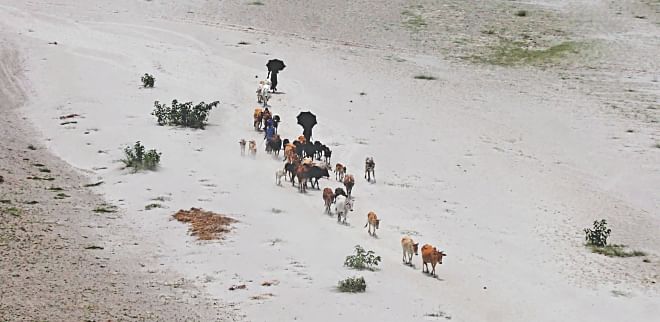River, where?
River, where?
Climate change upsets life, livelihood alike; major rivers flowing below usual level

Only a year ago, Mostafa Mia used to fish in the eastern channel of the Jamuna under the Bangabandhu bridge.
Now, the channel is dead; it is nothing but a strip of sandy land.
The water level of the Jamuna has never dropped to this low in the last one decade. At Bahadurabad point on May 14 this year, it was 14.51 metres above sea level, and 15.82m and 15.22m on the corresponding date last year and the year before.
With the river drying up, Mostofa, a fisherman from Char Beltia village of Tangail, is losing his earnings. “I used to earn Tk 700 a day last year. But this year my daily income is not more than Tk 300,” he says.
Liakat Hossain of the same village used to have boat trips for tourists from Beillabari ghat. He says, “Last year, there was water at the ghat point. It is all dry now. Tourists do not want to walk the sandy char land to get on a boat.”
According to the Water Development Board, the Jamuna, Padma, Meghna are now flowing at levels lower than that in mid-May in the last two years.
The trend is affecting all the small rivers, tributaries and canals, ruining livelihoods of fishermen, boatmen and others dependent on the water bodies.
The Padma at Hardinge bridge point was flowing at 5.36m above sea level on May 14 this year and 5.82m and 5.44m in 2013 and 2012.
On the same date, the water level of the Meghna at Bhairab bazaar point was 2.64m this year, despite some
rainfall in the Sylhet region. It was 2.69m and 2.78m in the previous two years.
Though the Teesta, the fourth major river of Bangladesh, usually flows at around 4,000 cusecs in the lean period, its water went down to 416 cusecs from March till the beginning of this month.
The Ghagot and other tributaries of the river are running dry too with the northern region waiting for rain.
Dr Ainun Nishat, climate expert and hydrologist, said there could be several reasons behind the fall in the river water levels. Lack of rain is one of them.
The effects of climate change are very much noticeable in Bangladesh. For instance, October now sees rainfall that was usual in July. Such changes are greatly affecting our rain-fed agriculture.
“We all know Sheuli is a flower of autumn, Bangla Ashwin month. But just today, I saw a tree full of Sheuli in this sultry summer weather,” he told The Daily Star on May 14.
In April, the country had rain that was 79 percent less than usual and around 60 percent less in March. Weathermen say such a situation will continue in June and July.
“If the current situation prolongs till June,” said Wais Kabir, former chairman of Bangladesh Agricultural Research Council, “it will affect the production of jute. Cultivation of aman will be delayed.”
Most importantly, the groundwater will not be recharged if it does not rain in the monsoon, and the Boro production next year will be hampered as irrigation for Boro is mostly dependent on groundwater, he added.
Md Shah Alam, director of Bangladesh Meteorological Department, said, “If it does not rain in June, it will be a dry monsoon in Bangladesh and agriculture will be hurt severely.”
And the whole South Asia is going to be affected, he added.
A statement on the website of Bangladesh met office reads: during the 2014 summer monsoon season (June-September), “below-normal rainfall” is likely over broad areas of western, central and southwestern parts of South Asia and some areas in the northeastern-most parts of the region.
This statement issued from the fifth South Asian Climate Outlook Forum (SASCOF-5) in Pune last month is the consensus outlook for the 2014 southwest monsoon rainfall over South Asia.
The forum was attended by experts from eight South Asian countries, including Bangladesh, from the World Meteorological Organisation (WMO). There was a consensus among them about the potential for adverse impacts of El Nino on the monsoon rainfall over the region.
However, the intensity of El Nino is uncertain. Other regional and global factors also can affect monsoon rainfall patterns over the region, the statement says.